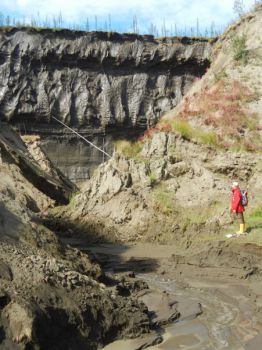
Permafrost revealed at Batagay, Siberia
- Research, led by the University of Sussex, has found that ancient permafrost has survived exceptionally warm past climates, as much as 4–5°C warmer than during the last 11,700 years
- Researchers have also found that the ancient permafrost is at least 650,000 years old, making it the oldest known permafrost in Eurasia
In remote northern Siberia, the world's largest permafrost landslide (i.e., the Batagay megaslump -- also known as the Batagaika Crater) reveals that ancient permafrost has survived past episodes of intense global warming but is sensitive to human-induced disturbance – according to a group of international experts.
In a new study, led by the University of Sussex, geoscientists from the UK, Germany and Russia have determined that the ancient permafrost, which is hundreds of thousands of years older than any other directly dated permafrost in Eurasia, has survived multiple warm episodes known as 'interglacials', including exceptionally warm and wet conditions during a 'super-interglacial' 420,000 years ago. Moreover, it has also survived warmer-than-present conditions about 130,000 years ago, when summer air temperatures in the Arctic may have been as much as 4–5°C warmer than during the last 11,700 years.
Though many scientific studies have shown that climate warming has caused thaw and loss of some thin, warm and ice-poor permafrost in recent decades, this study reveals that cold, thick and ice-rich permafrost has persisted for more than half a million years despite natural past climate warming of much greater magnitude than during the last century.
However, the fly in the ointment, is human activity. Despite the great age of the permafrost, the megaslump is geologically very young and triggered by human disturbance. Tree clearance and offroad vehicle movement during the 1940s to 1960s damaged the fragile vegetation cover that protected the permafrost from summer thaw. In turn, this promoted the formation of a hillside gully that rapidly cut down deep into the permafrost during the 1960s to 1980s, and then transitioned into a megaslump in about the 1990s. Currently the area of the slump exceeds 77 ha.
Astonishingly, the age of the ancient permafrost found at the bottom of the huge, 50-m deep and 0.8-km wide crater is at least 650,000 years old, providing an exceptional geological window into the environmental conditions, flora and fauna of the Ice Age.
The researchers were able establish a timeframe by the dating of sand grains by measuring the amount of light they emit, and dating of ice crystals by measuring chlorine isotopes they contain.
Permafrost is ground that remains at or below 0°C for at least two consecutive years and represents a geological product of climate. As climate warms, permafrost is expected to heat up, thin and contract in area. But the sensitivity of permafrost to climate warming varies. The permafrost at Batagay preserves in pristine condition abundant organic remains, from frozen carcasses of horse to bones of woolly mammoth, lemmings, plants, and ancient DNA.
Professor Julian Murton, from the University of Sussex, who led on the study, said: "The ancient permafrost near the town of Batagay has been resilient to natural climate and environmental change over multiple glacial–interglacial cycles, but is vulnerable to human-induced disturbance. Slump expansion by tens of metres each year since the 1990s has caused major disturbances to vegetation, hydrology and sediment transport in the area."
Prof Phil Toms, from the University of Gloucestershire, who led on the dating of the permafrost sand grains, said: "The site further demonstrates the potential of relatively novel dating techniques in uncovering the timing of past natural climate changes, across relatively understudied swathes of our planet that are now thawing and revealing their environmental histories."
Dr Thomas Opel, from the Alfred Wegener Institute, Germany, who co-led the fieldwork, said: "This ancient permafrost exposed in the Batagay Megaslump offers amazing potential to reconstruct past climate and environmental conditions using a suite of state-of-the-art techniques including stable isotopes and ancient DNA. This will help us to assess how past climate has controlled the formation and degradation of permafrost and to improve projections under global warming conditions".
The paper entitled, "A multi-method dating study of ancient permafrost, Batagay megaslump, east Siberia", has been published in the journal Quaternary Research and can be found here.






